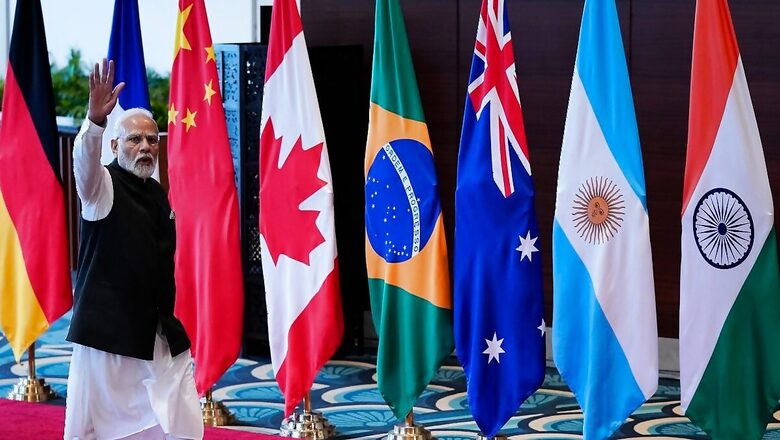
views
Main Desh Nahi Jhukne Doonga
Hai Mujhe Saugandh Bharat, Bhulu Na Ek Kshann Tujhe,
Rakt Ki Har Boond Meri, Hai Mera Arpan Tujhe
These words resonate in every step taken by Narendra Damodardas Modi over the last decade as the prime minister of Bharat. As he turns 74, one must acknowledge the staunch patriot in him. A visionary leader who has tirelessly endeavoured to set Bharat on the path to Atmanirbharta or self sufficiency.
There are many aspects to PM Modi’s governance model. However, this is an attempt to focus on the systematic shift of Bharat’s perception before 2014 as a ‘Soft Nation’ and ‘Weak Link’ to a strong, confident and dependable nation over the last 10 years. From non-aligned and largely submissive to asserting strategic autonomy and an aggressively defensive posture, Bharat under PM Modi has seen a significant psych upgrade. This hasn’t been easy, and this is far from complete. We have just about embarked on this journey and have a long way to go.
Sample this, the total length of India’s land and sea borders is 15,106.7 kilometres of land and 7,516.6 kilometres of coastline. We share our land borders with nine nations of which some are hostile. Nearly 6,000 kilometres of our land borders remain unfenced or not clearly defined. This is a serious security challenge. There is also a perennial two-front challenge on the eastern and western sides of Bharat and in the last decade, both sides have seen significant activity.
In February 2014, AK Antony, the then defence minister, told the nation that the Defence Ministry had used up 92 per cent of its budget and had no money to buy the much-needed Rafale fighter jets, adding that all major deals will have to wait until April 1.
Bharat was vulnerable. The enemy was chipping away on our sovereign territory via salami slicing on the one side and with a four-decade-old proxy war on the other. Then there was the serious challenge of narco-religious forces quietly working to destabilise the North-East states, especially along the Myanmar border. Our coastline was also vulnerable with the threat of another attack like 26/11 via the sea looming large. The adversary’s warships had started swirling dangerously close to our waters.
There was a lot to be done. Despite the many challenges and obstacles, Modi and team started the repair work. Work on border roads and infrastructure was initiated, veterans were roped in via think tanks to suggest effective ways to turn things around. OROP brought in the required belief that under Modi, there was an intent to get things done.
Meanwhile, PM Modi attempted to talk peace with pesky neighbours with the hope that they would take a step if he took two. However, reality bit and bit hard. The year 2016 tested Bharat’s resolve and mettle with Pathankot and Uri. Interestingly, there was a significant shift in PM Modi’s approach. While Pakistan was given some leeway post Pathankot attack, Uri was responded to with severe punishment. The surgical strike was a lesson for both Bharat and Pakistan.
Bharat under Modi wants peace but will punish those that take its affinity for non-violence as weakness. The strong, muscular yet benign posture started taking shape here. And the world took notice.
The red line with Pakistan was drawn. The process of systematic and thorough strategic demolition of Pakistan had begun. The Surgical Strike was the first page in the isolate Pakistan playbook being developed under PM Modi.
◆ September 2016: India conducts Surgical Strikes within PoK to eliminate terrorists responsible for the Uri attacks; sends a strong signal to Pakistan
◆ September 2016: India pulls out of SAARC summit to be hosted by Pakistan, three other countries follow, Pakistan completely isolated
◆ June 2018: India’s diplomatic efforts successful as Pakistan is formally placed on FATF’s Grey list despite China’s nefarious backing
◆ February 2019: India for the first time crosses international border to enter mainland Pakistan to launch an aerial attack on ISI-backed terrorists in Balakot. This is followed by Pakistan’s attempt to attack India and later, being shamed and forced to release WC Abhinandan.
◆ August 2019: Final blow to Pakistan’s proxy war in Kashmir as India abrogates Article 370, making the Constitution of India applicable to Kashmir
‘Saugandh Mujhe Iss Mitti Ki, Main Desh Nahi Jhukne Doonga’ was the promise that PM Modi made post-Balakot and carried it through soon after coming to power again in 2019. August 5, 2019, will be a Red-Letter Day forever in Bharat’s Itihaasa. Bharat became One Nation with One Constitution in the true sense this day. The abrogation of Article 370 was a gamechanger. With this huge move, PM Modi and his government put paid to the machinations of the enemy that wanted to severe J&K out of Bharat. It was a tectonic shift most ably managed. And, this hurt not just Pakistan but China too.
Two months post-Balakot, PM Modi played host to Xi Jinping in Mahabalipuram. The effort to make peace with another adversary was evident. But soon after, India walked out of RCEP in November 2019. It was clear to the government under PM Modi that RCEP wasn’t helping Bharat. At the peak of the Covid-19 first wave, the PLA made their move. Galwan happened. But unlike the past, Bharat didn’t meekly surrender and yield more of its sovereign territory to the bully. Bharat decided to counter China in equal measure, if not more. PLA soldiers were shocked at the bloody nose that they received.
PM Modi himself went to Ladakh and further embellished Bharat’s changed posture with ‘Veer Bhogya Vasundhara’ — Only the strong and brave get to enjoy the benefits of the Earth. Bharat told the whole world that it no longer shirks from flexing muscle and if required, will defend its borders with aggression.
The government under PM Modi struck a few telling blows to send a strong message to CCP-led China:
◆ June 2020: China tries mischief at Galwan, India brutally thwarts attempt. In the clash, as many as 38 Chinese soldiers are killed but China officially admits just four deaths on its side.
◆ June 2020: India bans TikTok and 38 other Chinese apps.
◆ July 2020: PM Modi visits Leh, boosts forces’ morale saying, “enemies of Mother India have seen your fire and your fury as well”.
◆ September 2023: India’s branding brings results as Reuters notes that US and European firms are shifting investment away from China to India
It didn’t stop here… PM pushed for Atmanirbhar Bharat and started aggressively coveting nations that were moving towards China for their manufacturing and sourcing needs.
DEFENCE DEVELOPMENTS TO BOOST BHARAT’s SHAKTI
◆ Re-establishment of Quad to Counter China: In 2017, India, Australia, Japan and USA revived the QUAD — a strategic forum between the four countries — as an attempt to counter China’s rising influence in the region. QUAD countries only came closer post the 2020-21 India-China skirmishes and have served as a countermeasure/check on China since.
DEFENCE AATMANIRBHARTA AND ITS IMPACT
● The Defence Acquisition Procedure (DAP) 2020 mandates 50 per cent indigenous content in procurement contracts, encouraging foreign OEMs to establish facilities in India.
● The Srijan Indigenisation Portal, launched in 2020, supports this with over 34,000 items listed for indigenisation.
● Two defence corridors in Tamil Nadu and Uttar Pradesh have attracted significant investments, including SAAB’s 100 per cent FDI project for the Carl Gustav M4 rocket system.
● Notable progress includes the INS Vikrant aircraft carrier and Project 17A frigates, with a focus on enhancing naval, missile, and electronic capabilities.
● The Centre has increased the domestic capital procurement budget from 40 per cent in 2020-21 to 75 per cent in 2023-24, with 25 per cent of this reserved for private-sector purchases.
● India’s defence production crossed Rs 1,00,000 crore in 2022-23, with a target of Rs 1,35,000 crore for 2023-24.
● DRDO’s Dare to Dream contest fosters start-ups, and a quarter of the R&D budget is allocated to academia and industry. India aims for Rs 35,000 crore in defence exports by 2025.
From a weak-minded approach of leaving our border infrastructure poor and bare in order to make it difficult for the enemy to enter in our territory to modernising and improving connectivity at an urgent pace, PM Modi has re-energised and revolutionised thinking. The enemy is taking note and has been forced to re-calibrate.
Yearly summary of roads constructed
BRO had completed following 257 border roads of 13,525-km number in last 5 years during 2017–22
• Arunachal Pradesh: 64 (3,097-km).
• Ladakh: 43 (3,141-km).
• J&K: 61 (2,382-km).
• Himachal Pradesh: (739-km).
• Uttarakhand: 22 (947-km).
• Sikkim: 18 (664-km).
• Rajasthan: 13 (884-km).
• Mizoram: 8 (590-km)
• Manipur: 8 (492-km).
The shape of our defence posture is increasingly getting more muscular. Yet, it remains benign. PM Modi has endeavoured to strengthen Bharat on the ground, in the air and in the seas. The S400 anti-missile system deal, the Scorpene deal, Rafale and Apache are among the many procurements made in the last 10 years, quite contrary to February 2014. PM Modi has also understood the importance of aerial security. Our space programme with focus on defence technology has grown by leaps and bounds.
INDIA’S JUMP INTO SPACE – WITH ASAT MISSILES AND MISSION SHAKTI
● DRDO successfully neutralised a satellite in space with its anti-satellite (ASAT) missile on March 27, 2019, in Mission Shakti.
● The successful mission demonstrated DRDO’s technical prowess and ability to defend country’s assets in space, the fourth dimension of warfare.
● The mission was one of the most complex operations undertaken by DRDO in which a missile launched from ground had to hit and neutralise with pinpoint accuracy a fast-moving satellite in orbit hundreds of kilometres away.
● India also raised its own Defence Space Agency under HQ Integrated Defence Staff (HQ IDS), and its technical counterpart, The Directorate of Special Projects, under DRDO in October 2018 and operationalised the same in June 2019.
As PM Modi turns 74, he can take pride in what has been achieved under his leadership in the last decade with respect to improving our defence posture. But he can’t rest on his laurels. Bharat faces many more challenges. The enemy on the two sides is still active. There is a renewed thrust to the proxy war. Drugs and drones are being used along with the conventional method of pushing in foreign terrorists via infiltration. The adversary on the Eastern front is scoping all options to force an easing of tensions along the LAC so that it can catch us off-guard again. Then there is a fresh front brewing.
With Manipur on the boil soon after a regime change in Bangladesh, there is imminent threat from narco-religious forces, Islamist forces and hegemonistic deep states both in the West and the East, to our national security and territorial integrity. But where there are problems, there is opportunity and where there is opportunity, solutions present themselves.
A fitting birthday reminder for a man for whom without a shred doubt, Bharat comes first.
Silsila Ye Baad Mere, Yuin Hi Chalna Chahiye, Main Rahoon Ya Rahu, Bharat Ye Rahna Chahiye


















Comments
0 comment